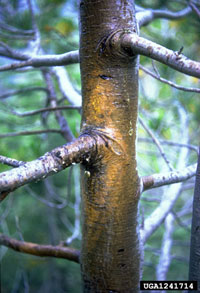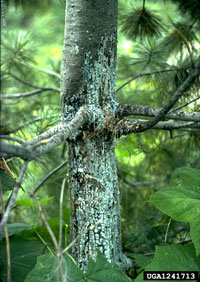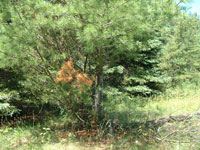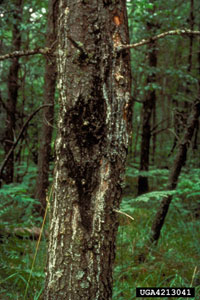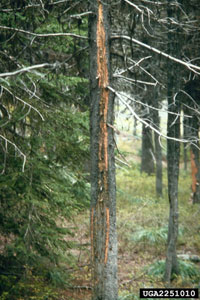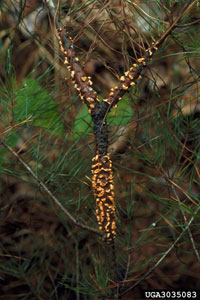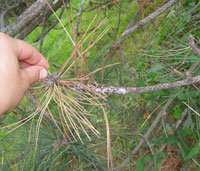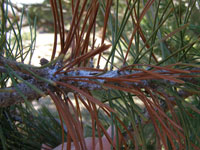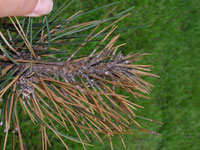Extension > Garden > Diagnose a problem > What's wrong with my plant? > Evergreen Trees and Shrubs > Pine > Sunken, cracked or discolored areas
Pine > Trunk/Branches > Sunken, cracked or discolored areas along branches or trunk
1 of 3
White pine blister rust
Cronartium ribicola
- All needles on one or several branches die and turn completely reddish-orange
- Young cankers are elliptical, bark appears swollen and discolored yellowish orange
- Older cankers exude large amounts of white sticky resin and have cracked bark
- In early spring, orange-yellow blisters appear on the bark of cankers that are 2 or more years old
- In summer, yellow-orange sticky liquid droplets form in cankers 3 years or older
- Only white pine and other five needled pines can be infected
- More information on White pine blister rust
2 of 3
Comandra, Stalactiform or Sweetfern rust
Cronartium comandrae, Cronartium coleosporioides, and Cronartium comptoniae
- When severe, canopy is thin, has poor growth, needles yellow, turn brown and die
- On young stems or branches, infection may appear as a swollen, elliptical area
- Infection develops into a long, flattened, resin soaked canker on the main trunk
- Sweetfern rust cankers frequently occur near the soil level and grow up to 6 ft. long
- Stalactiform rust cankers grow up to 25 ft. long along the main trunk
- Comandra rust cankers occur on the main trunk and rarely grow over 4 ft. long
- Ridges of wound wood may be present along edges of the canker
- Pale yellow blisters of powdery spores break through cracks in bark in spring, sticky orange drops form along canker edges in late summer to fall
- On young stems or branches, infection may appear as a swollen, elliptical area
- Jack and ponderosa pine most severely affected, but many 2-3 needle pines are susceptible
- Differentiation between the 3 species is most accurate with a lab analysis
- More information on Comandra, Stalactiform or Sweetfern rust
3 of 3
Diplodia shoot blight
Diplodia pinea
- New needles are brown, short and often glued together with resin
- Cankers are resin coated flattened areas on branches
- Needles and branch beyond canker turn brown and dies
- Tiny, black, pimple-like fungal structures on dead needles and pine cones
- Infected shoots and dead branches occur throughout the tree but most commonly in lower canopy
- Cankers and dead needles can appear rapidly after wounding from hail, drought or other stress
- Olive to dark brown streaking in sapwood below cankers
- Common on Austrian, red and Scots pine
- More information on Diplodia shoot blight



